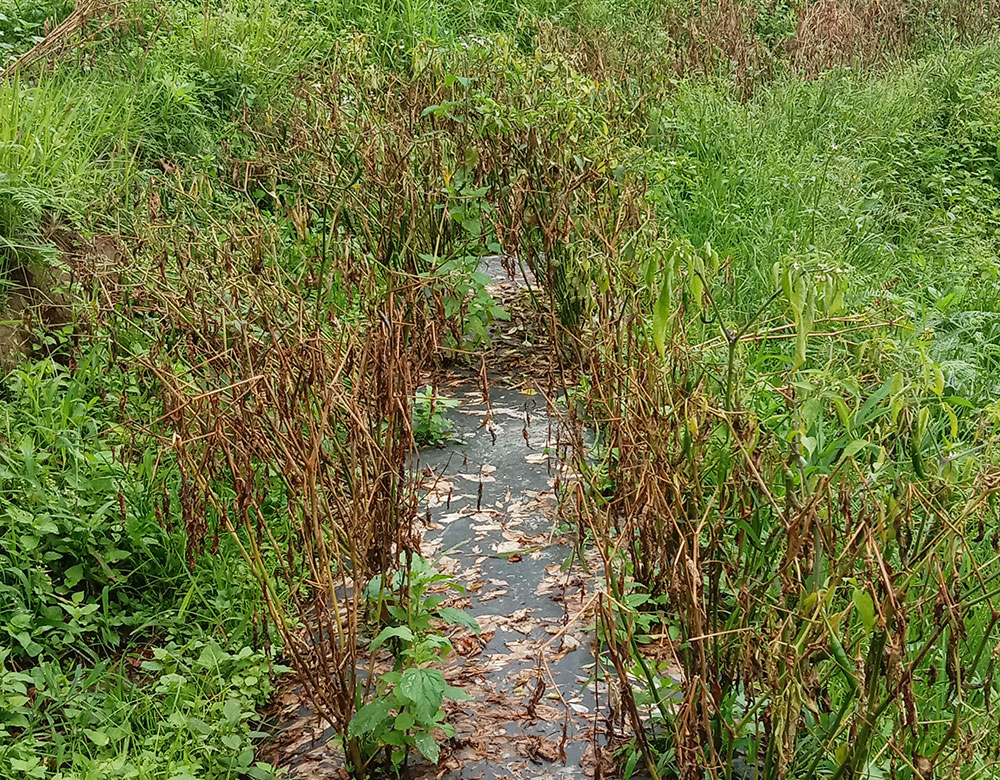With no returns, farmers are losing interest
Choki Wangmo | Tsirang
Most farmers in Tsirang, who took up green chilli (jitsi ema) cultivation on a commercial scale amidst the Covid-19 pandemic, are confused and losing interest.
A farmer in Doonglagang cultivated small green chillies on his farm last season. Before fruiting, the chillies started to turn yellow from the tip. The leaves and roots started to rot.
Although the farmer used mulching plastic, nothing saved his harvest, which he suspects could be affected by high humidity caused by erratic monsoon. “I am beginning to lose interest,” he said.
His mother, Monta Maya, who tended the field, said that after failure last season, she tried changing the plots this season but situation remained the same. “I have reported the issue to agriculture extension officials but they gave few pesticides, but it did not work.”
She has now stopped tending to her field.
Like her, about 30 households in the gewog reported the same issue.
The situation is no different among farmers in Gosarling, Sergithang, Padtshaling, and Barshong gewogs.
Naini Maya Rai, who has started green chilli cultivation three years ago in Pemathang in Gosarling, said heavy monsoon could have caused the disease.
This year, she cultivated in an acre land.
She said that although she consulted the agriculture extension officer, she did not have access to pesticides due to the lockdown. “The official told us to use organic measures to control such infections, which according to them is fungal infection but we don’t know how.”
In ideal conditions, she grew as much as 500kgs of chillies a year. “I sold about 100 to 200 kgs this year and earned Nu 35,000.”
Farmers allege that the dzongkhag encouraged commercial agriculture among farmers but lacked proper monitoring.
Today Tsirang has 6,000 households involved in vegetable production with more than 2,500 households growing on a large and commercial scale. Tsirang has grown winter chillies on more than 50 acres in seven gewogs.
Compared to 20 households in 2019, last year, 76 farmers from three chiwogs of Sergithang Toed, Tashithang and Sergithang Maed cultivated chillies on 31 acres of land.
Despite bumper chilli harvest in Sergithang last year, Sanman Subba said the situation was different this year. He has grown chillies in more than an acre of land.
Two tonnes of his produce were damaged.
Ash Bahdur Subba from Pangthang chiwog in Padtshaling gewog said that he wasted about 250kgs of green chillies to infection this season. “It could be due to rain and wind.”
The dzongkhag senior agriculture officer, Dorji Gyeltshen, said chilli wilt caused by bacteria has affected the produce.
He said that it was common during monsoon due to poor drainage.
He said that such conditions had been ongoing for a few decades in the country and despite discussions even in the Parliament, no concrete solutions could be found. “We need to be cautious from seed source till harvest as the bacteria thrives and spreads in any condition and worsens during monsoon.”
The bacteria, according to him, moves freely in marshy soil and spreads into larger areas. “It can also spread when raindrop splashes from the infected soil and when infected tools are used for gardening.”
He said sterilising seeds, solarising soil, raising beds, proper drainage, treating seedlings with chemicals, for example, were some of the preventive measures.
But the farmers were not aware.
Dorji Gyeltshen said that farmers couldn’t take up all the packages and the diseases reappear when the monsoon is heavy and have conducive environment to thrive.
He said that farmers in Tsirang were informed about such measures.
According to the agriculture officer, once the diseases are in the field, farmers need to avoid cultivating the chillies and vegetables of the same families such as tomato, potato, and eggplants in the same field for the next few years to break the disease cycle. “However, such practices are not viable since farmers have small landholdings.”
Agriculture extension officer of Doonglagang gewog, Naresh Bhandari, said that chilli blight symptoms include sudden and severe yellowing, browning, spotting, withering, or dying of leaves, flowers, fruit, stems, or the entire plant.
Most blights are caused by bacterial or fungal infestations, which usually attack the shoots and other young, rapidly growing tissues of a plant.
He said fungal and bacterial blights occur under moist conditions and most economically important plants are susceptible to one or more blights, including chilli, tomatoes, and potatoes.
He said that growing chillies under shades in greenhouses or poly houses to avoid direct contact rain was one of the solutions.
But lack of funds and affordability has affected the implementation.
Edited by Tshering Palden


